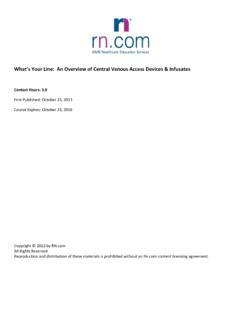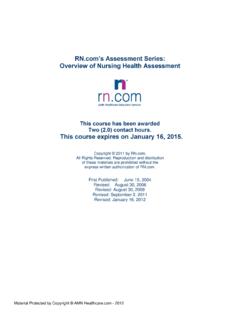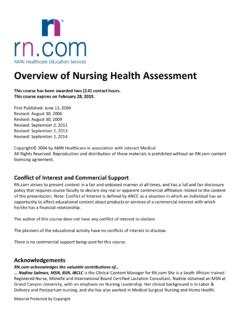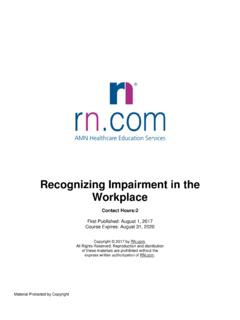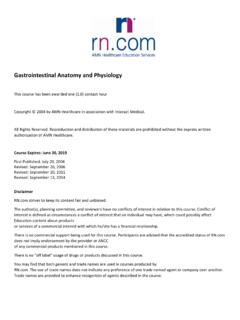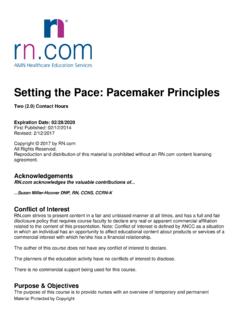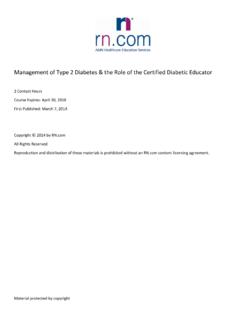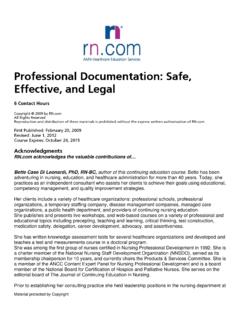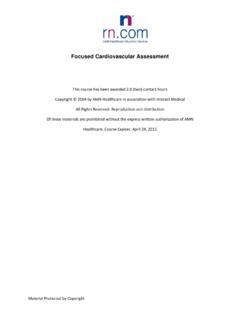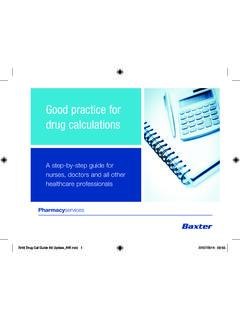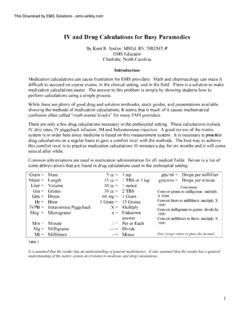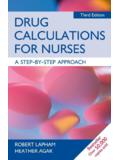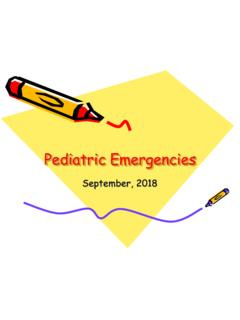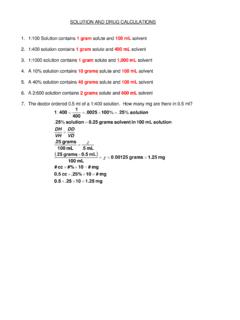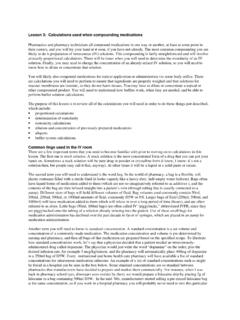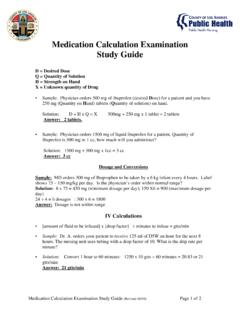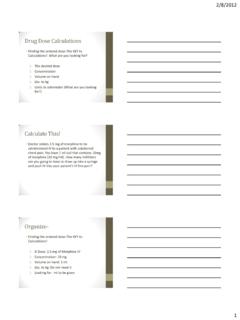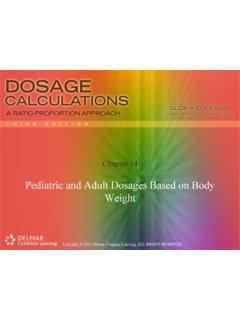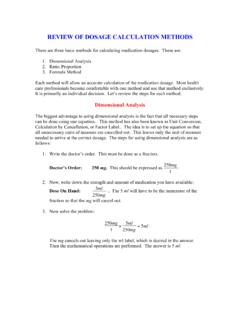Transcription of Critical Thinking: Nursing Calculations Part 2 - RN.com
1 Presented High Bluff DrSan Diego, CA 92130 This course has been approved for two (2) contact course expires on April 20, 2004 by Rights Reserved. Reproduction and distribution of thesematerials are prohibited without the express writtenauthorization of Published: April 20, 2004 Critical thinking : Nursing CalculationsPart and ..4 Keys to calculation Success ..5 Conversions ..8 Overview of Healthcare related Conversions ..9 Metric Scale .. Customary System and Metric Unit Conversions .. 10 Conversions between the Centigrade and Fahrenheit Temperature Scales .. 11 Conversion Math: Equivalents .. 11 Conversion Math: Ratio/Proportion .. 11 Conversion Math: Formula Method .. 13 Conversion Math: Dimensional Analysis .. 14 Conversions In Nursing Practice ..15 Conclusion ..25 References ..26 Post Test Viewing acknowledges the valuable contributions Bette Case.
2 Since 1993, Bette has practiced as an independent consultant to a broad spectrum of healthcareorganizations including American Mobile Healthcare, Inc., professional schools, professional organizations,hospitals, disease management companies, managed care organizations, a public health department andproviders of continuing Nursing education. She works with her clients to assist them in achieving their goals byusing educational, competency management and quality improvement strategies. She is also a partner inClinical Care Solutions, Inc., which focuses its business on improving medication presents continuing education offerings at a variety of national and regional conferences. She has publishedon the topics of Critical thinking , test construction, competency testing, precepting and career development.
3 Shehas also written numerous continuing education self-study courses and prepared competence tests for a varietyof Nursing specialties. She serves on the editorial board of the Journal of Continuing Education in Nursing andon a regional advisory board for Advance to establishing her consulting practice, she held leadership positions in the school of Nursing and thenursing department at Michael Reese Hospital and Medical Center in Chicago, has taught Nursing students of all levels and college of education students. As a practicing nurse sheenjoyed the roles of staff LPN, medical surgical staff nurse, school health nurse and camp is an active member of the Nursing Staff Development Organization (NNSDO) and was among the firstgroup of nurses to receive certification in Nursing Staff Development and Continuing Education from theAmerican Nurses Association Credentialing Center (ANCC).
4 She earned her BSN at Syracuse University and her MSN and in educational psychology at LoyolaUniversity of AND OBJECTIVESThe purpose of Critical thinking : Nursing Calculations part 2 is to provide information about basic factsand principles of Calculations related to conversions between different measurement Identify reasons why nurses need to maintain competency in performing selected Calculations eventhough technology and pharmacy support relieves nurses of performing Calculations in many Describe selected basic concepts, facts and principles of algebra and Perform Calculations correctly using:a. Formula (where applicable)b. Ratio and proportion4. Identify advantages and disadvantages of the different calculation methods:a. Formula (where applicable)b. Ratio and proportion5.
5 Convert correctly between selected units of measure:a. Within the metric systemb. Between United States Customary measures and the metric systemc. Between selected cooking measures and the metric systemd. Between Celsius (centigrade) and Fahrenheit temperature scales6. Calculate drug dosages correctly, finding correct dosages and correct amounts to administer givenprescriber orders, selected patient parameters, and concentrations and amounts on you are a veteran nurse or a new graduate, medication safety is a Critical part of your job. Patients safety and lives depend on receiving the correct dose of medications. This three- part series of courses reviewsbasic skills related to safely calculating medication 1 of the series deals with the metric system and conversions to and from the metric system.
6 part 2 considerscalculations related to medications and part 3 addresses IV 2 of this series reviews the conversions from part 1 and puts these concepts to use in real world clinicalsituations. Applying the concepts necessary to correctly calculate oral and injectable medications is TO calculation SUCCESSSome of those Top Ten may apply to your work situation at least partially. And to add further support to thelist, initiatives directed toward improving medication safety recommend that Calculations be performed bycomputer algorithm rather than by practitioners using calculators or paper and pencil (USP, 2003). HOWEVER,responsible professionals cannot afford to become complacent and place blind trust in technology - particularlynurses, who assume accountability for all drugs they prepare and administer medications safely, nurses must avoid total dependence on technology to performcalculations.
7 Safe practitioners question themselves to eliminate risks of harm to patients. Sample questionsinclude: I set the pump to infuse at 125 mL/hr is what I see in the drip chamber consistent with that rate? This dose is ten times what I usually see for this type of patient could a decimal point be out of place? How could one mg/kg amount to that large a dose for such a small patient? If I prepare that dose with these tablets, I ll be giving the patient 10 tablets does that make sense?The safe practitioner maintains a state of risk-awareness continuously assuring that there s nothing wrong withthe as hospitals have emergency generators to supply electrical power in the event of power outage, the nursemust be prepared to back up some of the technology involved in safe administration of medications to knowhow to calculate IV drip rates for dose preparation by drug manufacturers and by pharmacists helps to assure safety.
8 But occasions arisewhen unit dose preparations are not available, when the pharmacist cannot respond as quickly as necessary orwhen limited pharmacy resources restrict unit dose preparation by when all systems are go when the technology works well and pharmacy support is optimal the nurseremains responsible for safe administration of medications directly to patients. To fulfill this responsibility, thenurse must maintain competency in basic medication Ten ReasonsWhy Nurses Don t Think They Need to Maintain Competency in Calculations1. The computer does The pharmacy does The IV infusion pump does We have charts and tables that do The drug companies take care of We use unit It s just a Nursing school We have a unit-based Math is just not one of my It s not a good use of my the medical errors reported to DoctorQuality, a web-based reporting system, 40% were medication findings implicate calculation errors in many medication Research Findings Related to drug calculation ErrorsSourceFindingsDavis & Cohen, 198112% of med errors in hospitals were errors in preparation andadministration of medicationPerlstein, et al, 1988On a calculation test:1/12 Calculations by NICU nurses were incorrect by 10-fold1/26 Calculations by NICU pediatricians were incorrectBeckman, 1996 National Malpractice Database.
9 19% of Nursing malpractice entries: adverse events in medadministration; of these, 29% are wrong dose errorsLesar, et al, 1997Of prescribing errors studied: were due to incorrect dosage calculation were errors in use of calculation , decimal points, orunits or rates of expression involved decimal, math or dosage error involved use of wrong equationArgo, et al, 2000 Top 10 Fatal Med Errors: #6. Miscalculation of digoxin dose forinfants and childrenPhillips, et al, 2001Of errors reported to the FDA 1993 1998: Improper dose accountedfor 41%; Dose miscalculation 13%.MEDMARX 2001,released 2002IV medications accounted for 54% of errorsIncorrect dose accounted for 34%Moore, et al, 2002 Pediatric patients are 3 times more likely to experiencemedication errors than adults of errors involve children 60% of pediatric errors are calculation errorsFor most drug calculation problems, there is more than one method for arriving at the correct answer.
10 Duringyour basic Nursing education, you undoubtedly learned at least one approach for each type of problem. Thesecourses give you an opportunity to refresh your previous knowledge of Calculations and gain new insights andtechniques for approaching USE THIS SERIES MOST EFFECTIVELY:1. At intervals throughout the course you will find Abbreviation Alerts!!! Although abbreviations do notenter into the calculation procedure directly, unclear abbreviations have been implicated in medicationerrors. Safety experts at the Institute for Safe Medication Practices (ISMP), the Joint Commission forAccreditation of Healthcare Organizations (JCAHO) and the National Coordinating Council forMedication Errors (NCCMERP) have recommended that healthcare professionals discontinue the use ofcertain common abbreviations.
